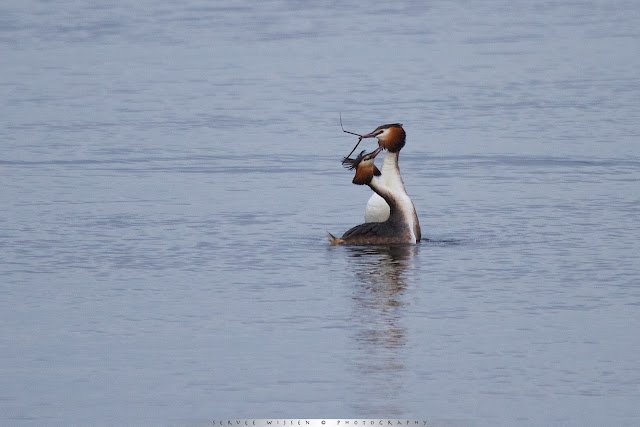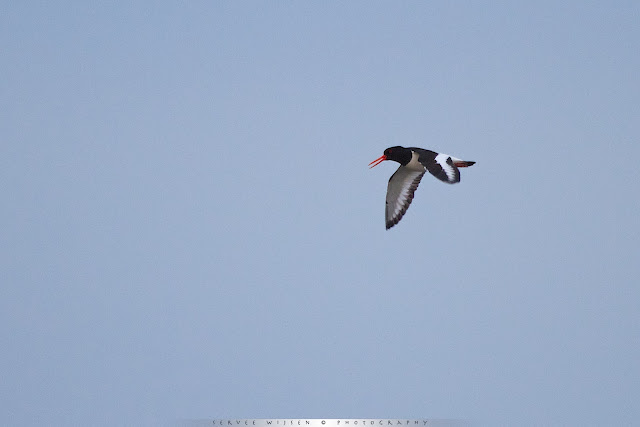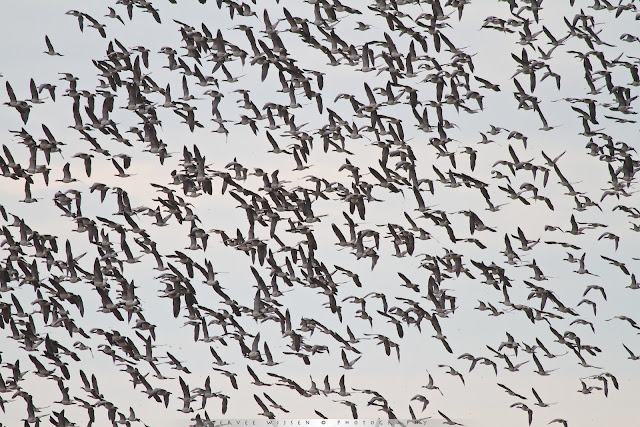Waar blijft die lente? Het is nog bitter koud buiten maar de eerste tekenen van de aanstaande lente zijn al wel te zien. Grutto's zijn al massaal aanwezig in de polder, al is het maar de vraag of ze gaan broeden als de kou zo lang aanhoudt. Als er weinig voedsel te vinden is willen ze namelijk nog wel eens een broedjaar overslaan.
-------------------------------------------------------------------------------------------
Where is Spring? It's still bitter cold outside but the first signs of spring are visible. Black-tailed Godwits are present in large numbers already, although it's uncertain if they are going to breed if the cold lasts any longer. When there is a lack of food they simply skip a year.
Ook de baltsende Futen zijn een teken dat het voorjaar voorzichtig begonnen is. Met hun prachtige synchrone waterballet maken ze elkaar het hof.Where is Spring? It's still bitter cold outside but the first signs of spring are visible. Black-tailed Godwits are present in large numbers already, although it's uncertain if they are going to breed if the cold lasts any longer. When there is a lack of food they simply skip a year.
 |
| Grutto - Black-tailed Godwit - Limosa limosa |
 |
-------------------------------------------------------------------------------------------
The courtship display of the Great Crested Grebe is also a sign of spring starting. With their beautiful synchronous water ballet they court each other.
 |
| Baltsende Futen |
 |
 |
Enkele Nonnetjes zijn in paartjes aanwezig. Van deze kleine zaagbekken heeft alleen het mannetje een prachtig wit zwart getekend verenkleed. Ook deze vogels zijn 's winters in behoorlijke aantallen in Nederland te vinden bijvoorbeeld in het Markermeer, maar ze trekken naar het noorden om te broeden. Dat doen ze niet op de grond maar in holen van bijvoorbeeld Zwarte Spechten in bomen.
-------------------------------------------------------------------------------------------
A couple of Smews flies by. The male of this species has a beautiful black-and white dress. These birds can be seen in large numbers in the Netherlands during winter, for example in the Markermeer, but they migrate north to breed.
they nest in trees and use holes made by Woodpeckers.
A couple of Smews flies by. The male of this species has a beautiful black-and white dress. These birds can be seen in large numbers in the Netherlands during winter, for example in the Markermeer, but they migrate north to breed.
they nest in trees and use holes made by Woodpeckers.
 |
| Paartje Nonnetjes - Pair of Smew - Mergellus albellus |
 |
| Nonnetje (m) - Smew (m) - Mergellus albellus |
Ook de Lepelaars zijn gearriveerd en wachten op beter weer. Zij zullen wel in ons land broeden:-)
-------------------------------------------------------------------------------------------
Spoonbills also arrived and wait for better weather. They will breed in our country:-)
Spoonbills also arrived and wait for better weather. They will breed in our country:-)
 |
| Lepelaar - Spoonbil - Platalea leucorodia |
Een prachtig eendje die Brilduiker, hier een mannetje. Deze vogel is een zeldzame broedvogel in Nederland.
-------------------------------------------------------------------------------------------
A beautiful small duck, this Goldeneye, this here is a male. This bird is a rare breeder in the Netherlands.
A beautiful small duck, this Goldeneye, this here is a male. This bird is a rare breeder in the Netherlands.
 |
| Brilduiker - Common Goldeneye - Bucephala Clangula |
 |
| Brilduiker - Common Goldeneye - Bucephala Clangula |
Verder waren er in de Eempolder nog Tureluurs, Smienten, Scholeksters, Grote Zilverreigers, en honderden Brandganzen te zien. Die laatste zullen ook massaal naar het hoge noorden (o.a. Spitsbergen) trekken om te broeden op rotsen en kliffen. Sinds 1984 broeden ze echter ook in ons land. Waarschijnlijk verleid door ontsnapte tamme soortgenoten.
-------------------------------------------------------------------------------------------
-------------------------------------------------------------------------------------------
There were Redshanks, Wigeons, Oystercatchers, Great White Egrets and hundreds of Barnacle Geese to be seen today. These Geese will migrate north up to Spitsbergen to breed on cliffs. Since 1984 they also breed in the Netherlands, possibly tempted to do so by escaped congeners.
 |
| Smient - Wigeon - Mareca penelope |
 |
| Grote Zilverreiger - Great White Egret - Casmerodus albus |
 |
Kuifeend - Tufted Duck - Aythya fuligula
|
 |
| Scholekster - Oystercatcher - Heamatopus ostralegus |
 |
| Brandgans - Barnacle Goose - Branta Leucopsis |
 |
Greetzzzz, Servee
Geen van deze foto's mag zonder mijn schriftelijke toestemming worden gebruikt voor publicatie of welk ander doel dan ook. Een link naar deze pagina is uiteraard wel toegestaan. Neem voor meer informatie contact op via mijn website www.serveewijsen.com
-----------------
None of the contents or photos published here may be used for publication or any other purposes without my written permission. linking to this page is permitted. For more information on using these images please contact me through my website www.serveewijsen.com
